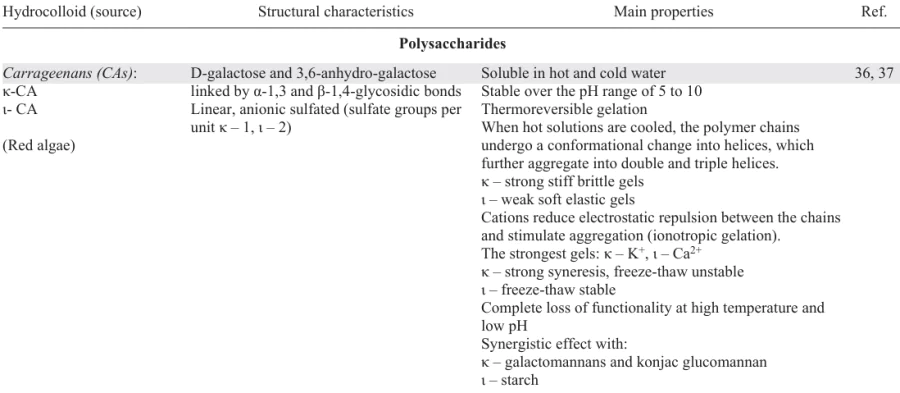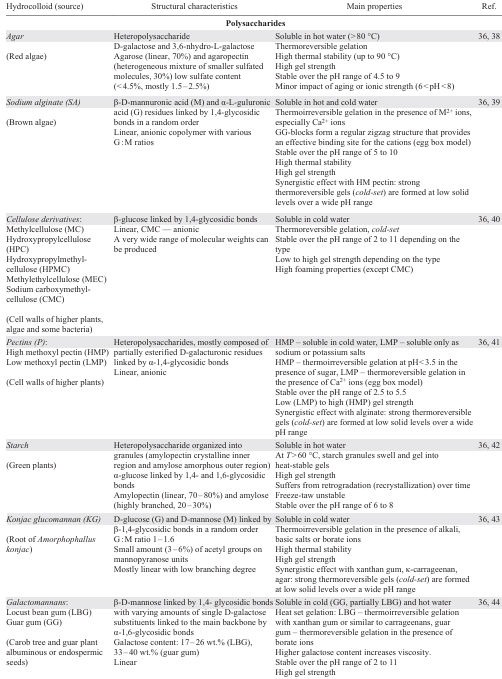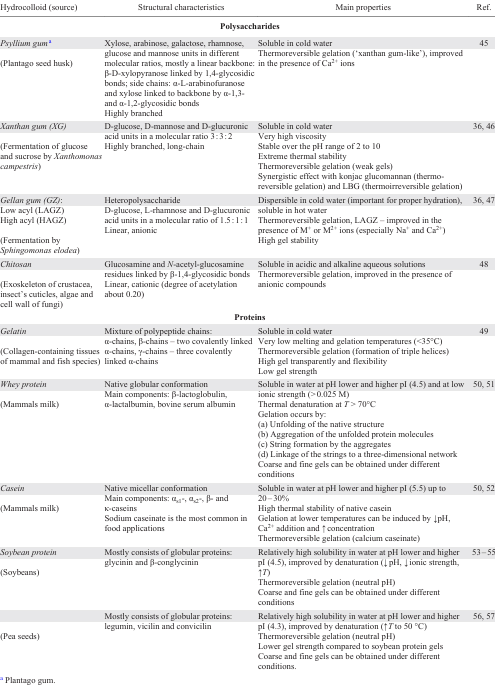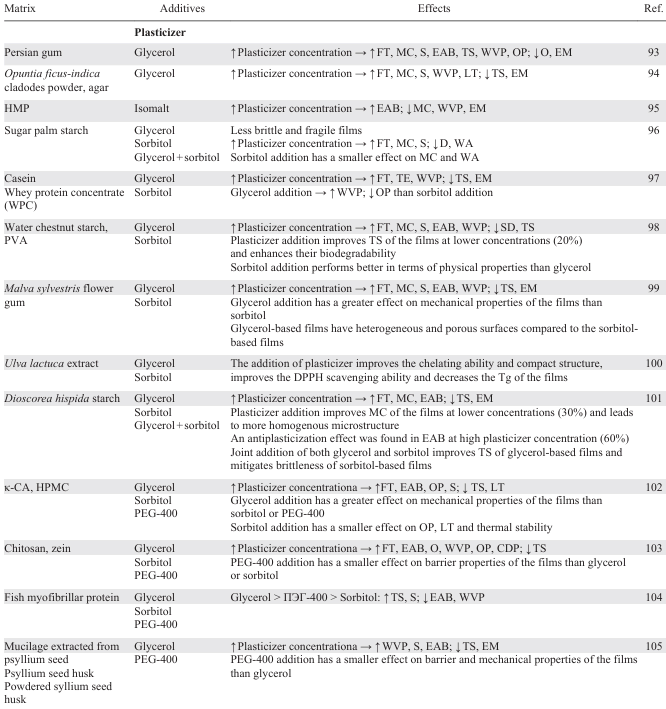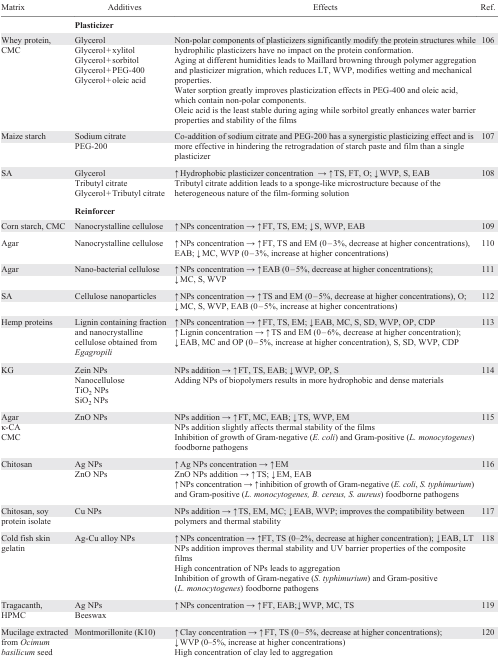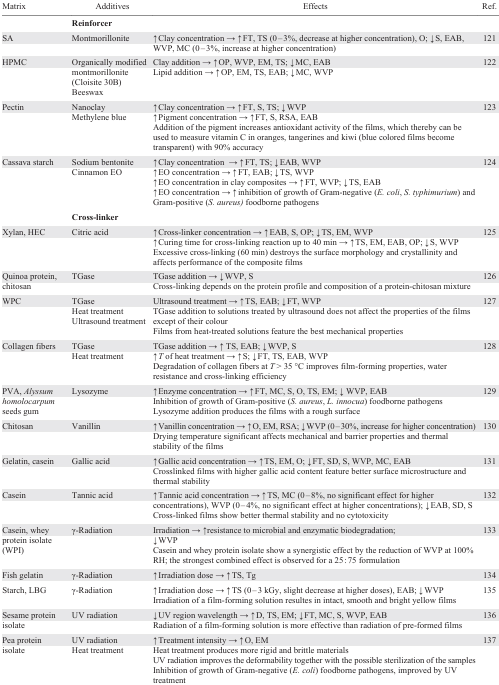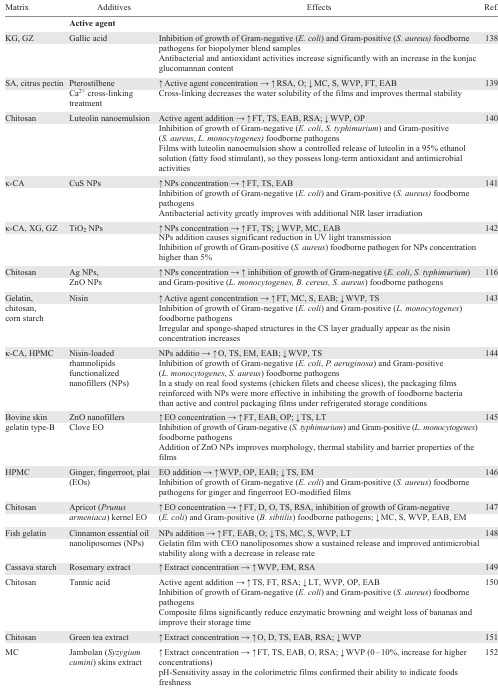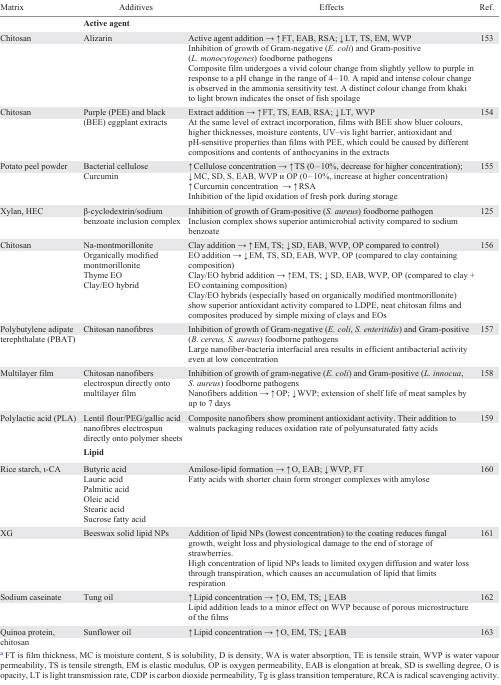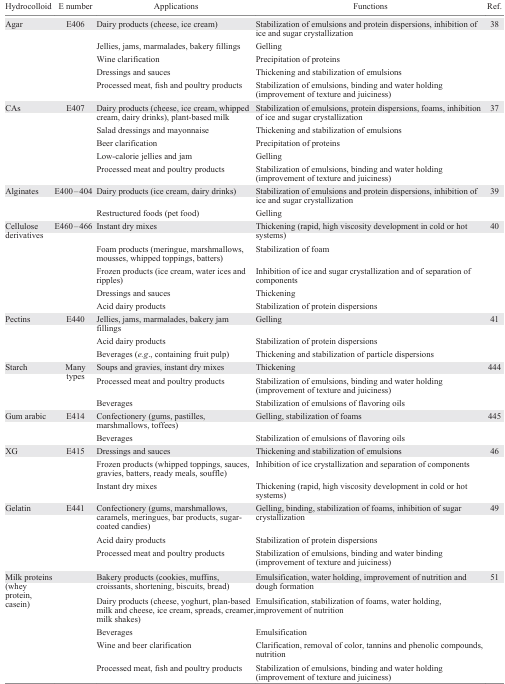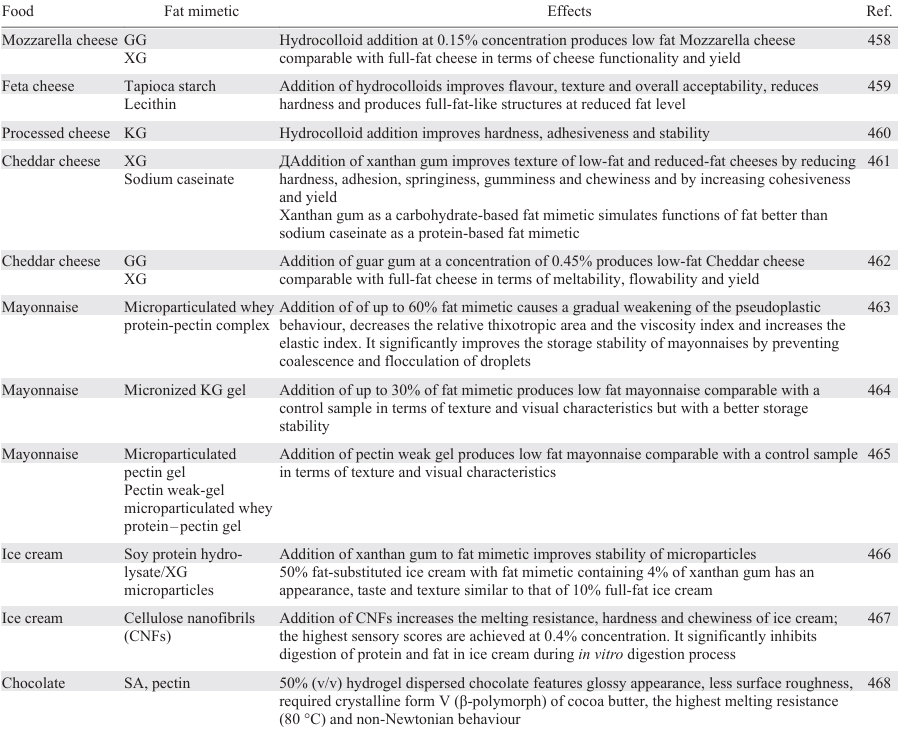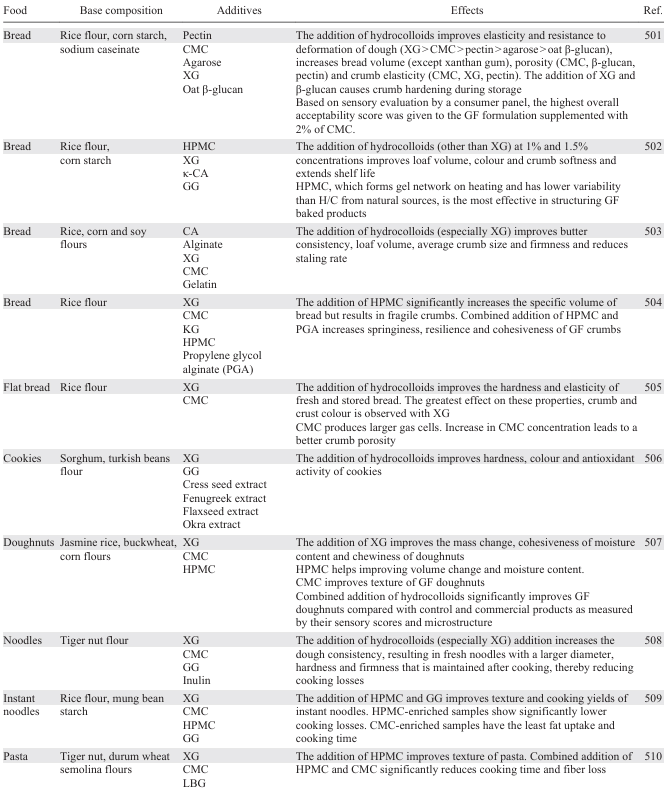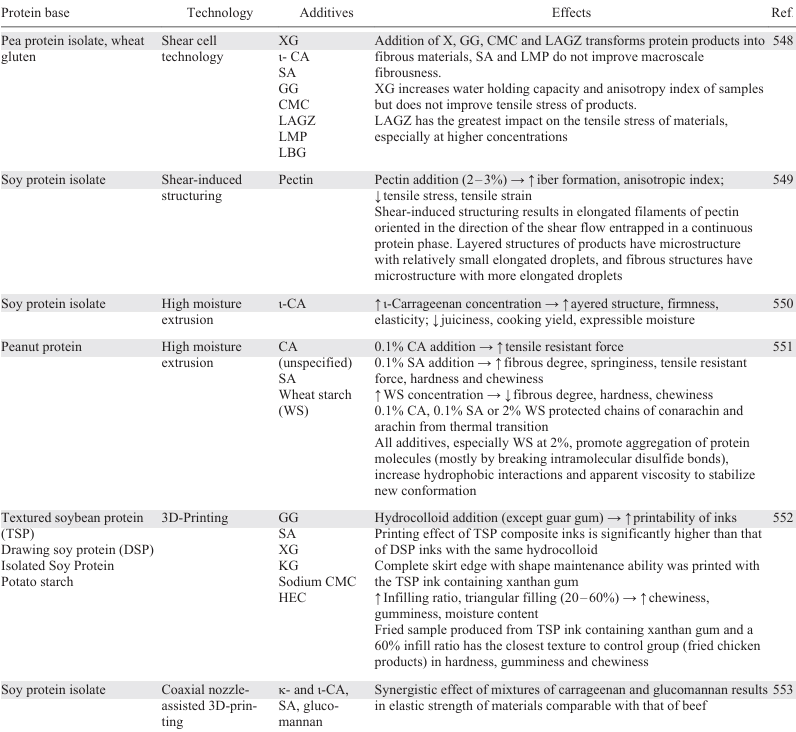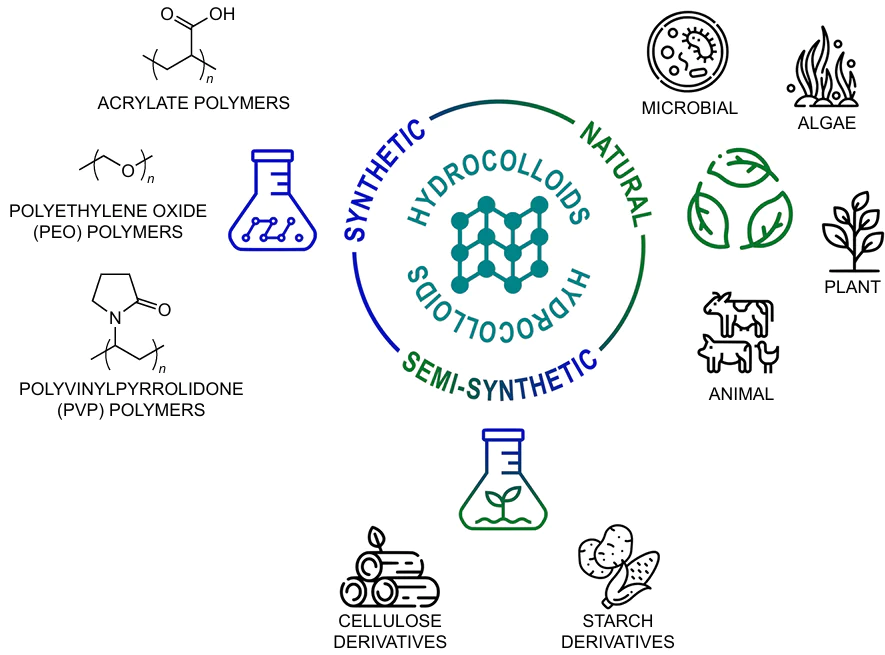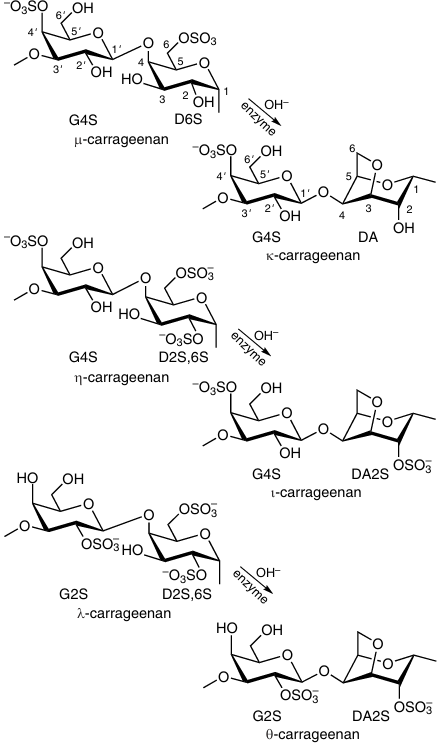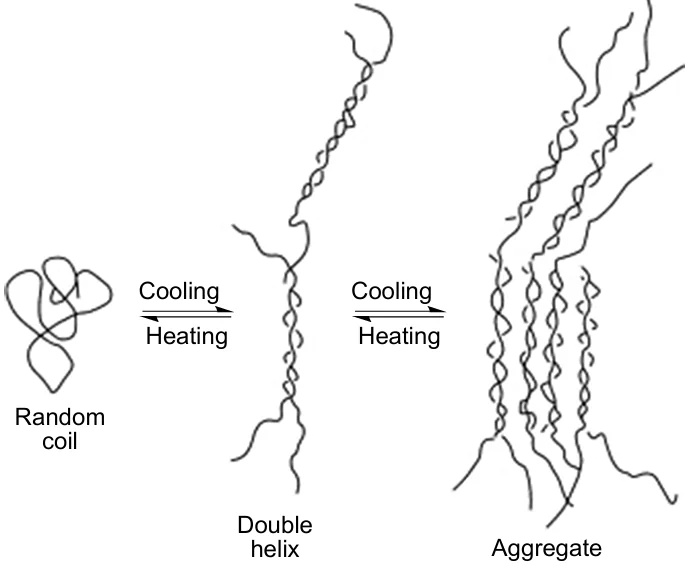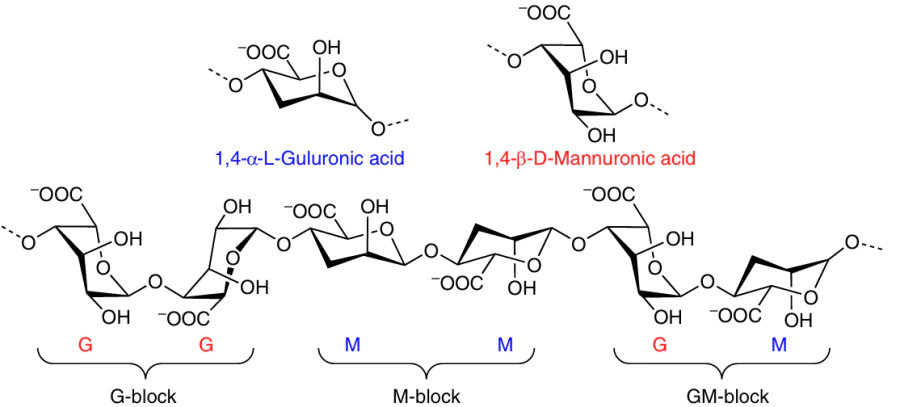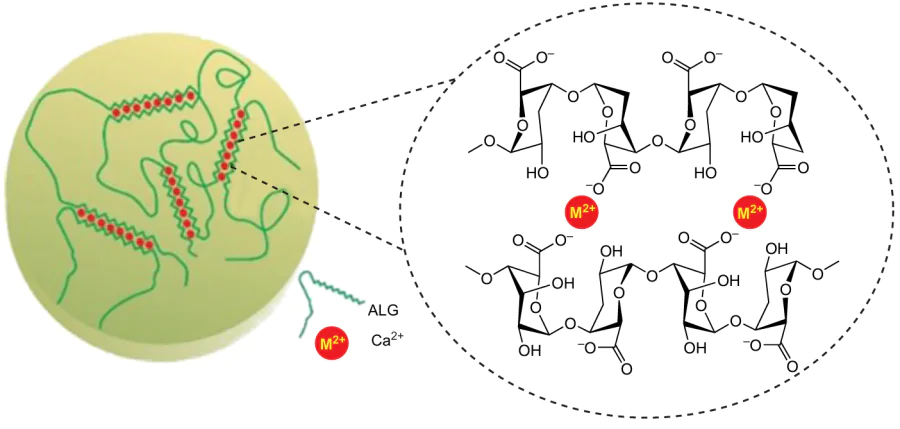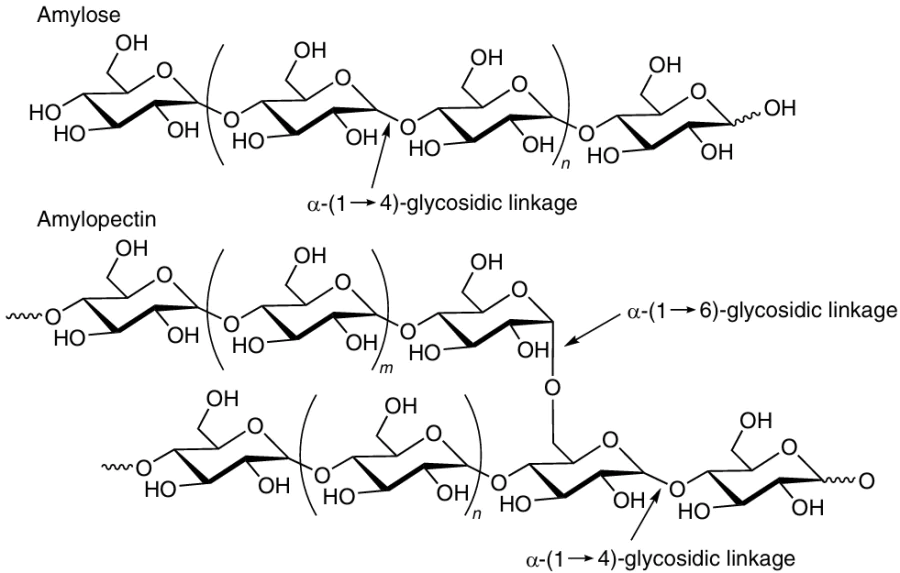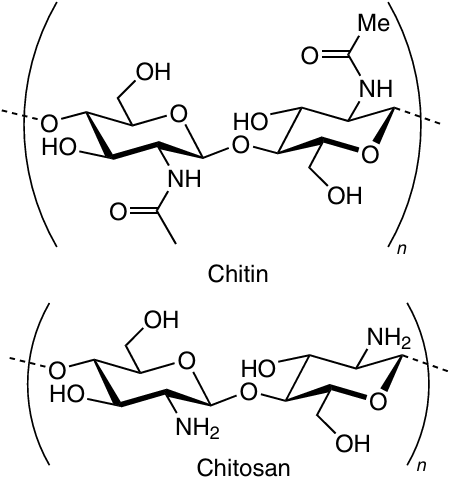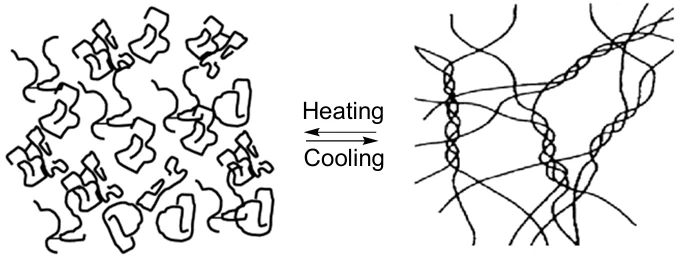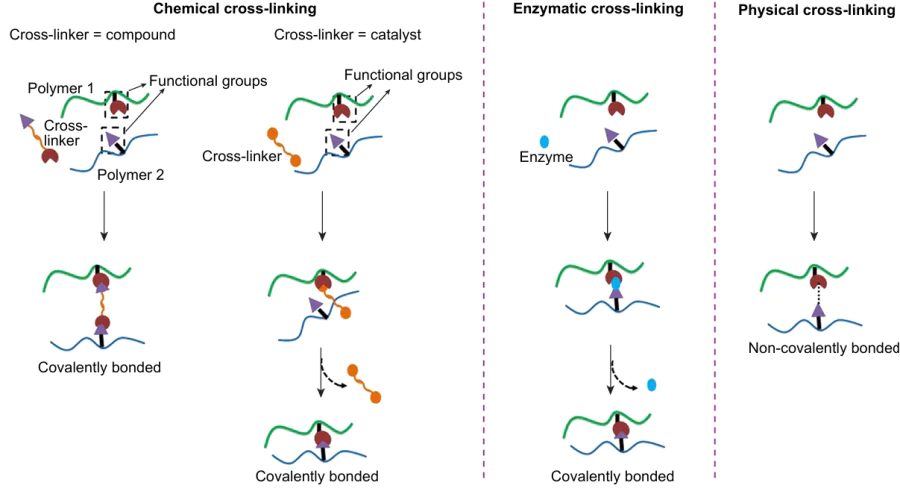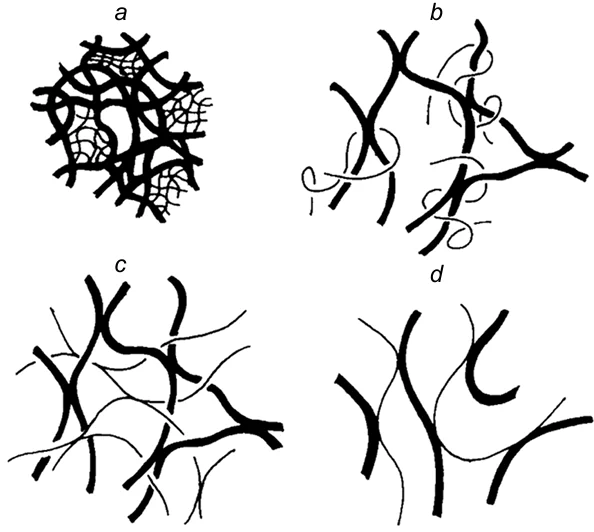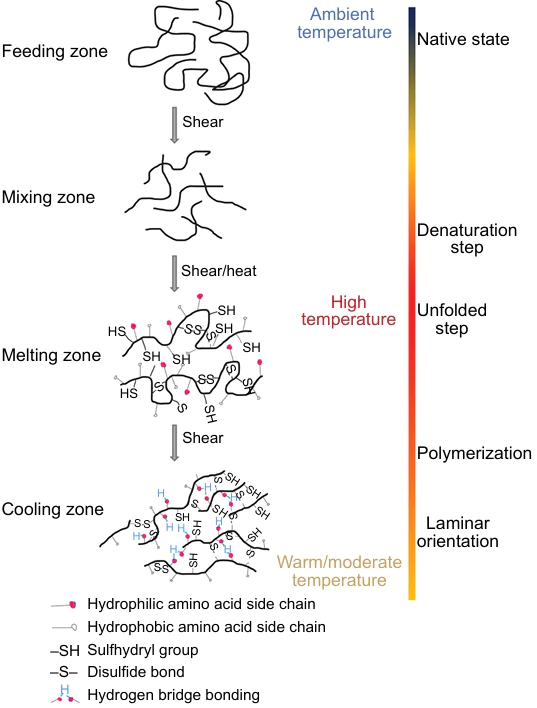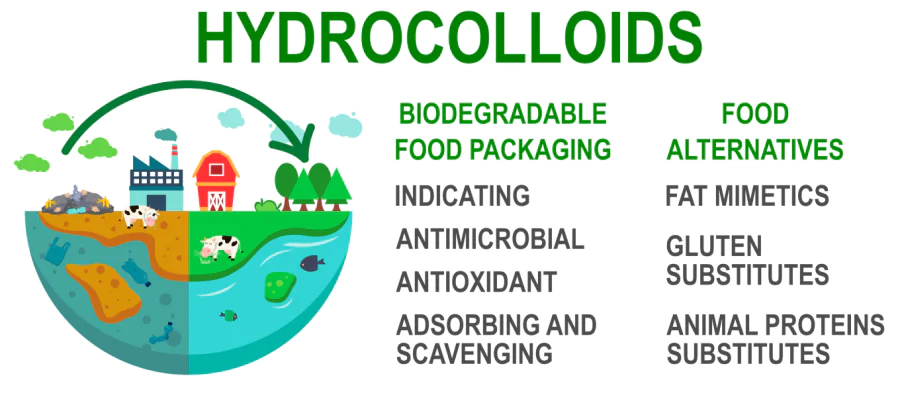Keywords
Abstract
Consumer demands for more sustainable approaches towards traditional food-related products made natural hydrocolloids a focus of the modern food industry. Featuring biocompatibility, availability and unique physicochemical properties, hydrocolloids are infiltrating the trending production of guilt-free food alternatives and biodegradable functional food packaging. Recent research has highlighted the challenges in creating these products, which can be solved by a deeper understanding of the interactions between the components of a complex hydrocolloid-based mixture. This review summarizes the applications of natural hydrocolloids as promising multifunctional materials for innovative technologies that prioritize safety and sustainability of food-related products. It also provides an overview of their features with a focus on the gelling behaviour and ways to improve the hydrocolloid matrix to produce the materials with the desired texture, smell, appearance and functional properties.
The bibliographyincludes 563 references.
1. Introduction
Global environmental problems guide the directions of modern material engineering. The oversaturation of landfills and oceans with plastic waste caused different biodegradable materials to appear on the market as a replacement of traditional petroleum-based plastics.1, 2 One of the major sources of the plastic waste,3 the food industry, also focuses its efforts on introducing a new generation of greener materials into mass production.4
Over the past two decades, a popular topic of research was bioplastics, the polymers obtained from biological materials or renewable raw materials.5, 6 A switch to such materials would significantly reduce the enormous CO2 emissions generated by the production, use, disposal and recycling of plastics.7 Although bioplastics are still inferior to traditional plastics,8, 9 they play an important role in many industries, such as food production and agriculture.10, 11 New bioplastics and bioplastic composites are often sought for to meet the needs of the growing packaging market.12
There is a misconception that all the bioplastics are biodegradable and safe for the environment. Unfortunately, this is far from being the case. The broad term ‘bioplastics’ refers to natural biopolymers, polysaccharides or proteins as well as to traditional plastics made from biological materials. The biodegradation of some of these materials is conditional, as the decomposition requires certain criteria to be met, which may not be achievable outside the laboratory.13 Among others, there is still a debate on the safety of polyvinyl alcohol (PVA), a water-soluble synthetic polymer used as shells for laundry detergent capsules, due to its accumulation in the oceans.14, 15 Many bioplastics also have vapour permeability and mechanical properties that are inferior to those of traditional packaging materials, thereby resulting in a decrease in the shelf life of foods in such packaging and the need to revise the storage conditions. Therefore, many factors16–18 should be considered while assessing the economic and environmental benefits of bioplastics.
The known biocompatibility and availability of natural biopolymers make them superior to other bioplastics. Water-soluble polysaccharides and proteins, the so-called hydrocolloids,19, 20 are widely used in the food industry as thickeners, emulsifiers and stabilizers. Hydrocolloid-based composite films made from hydrocolloids that form gels (i.e., robust three-dimensional networks in aqueous solutions) have a great potential as food packaging materials.
At the same time, the growth of the world population raised many questions on the ecological and ethical nature of the modern animal agriculture. One of the challenges of the last decade was the creation of foodstuff from artificial or plant sources as substitutes for animal protein, which involves many psychological factors. Modern alternatives to animal products appear at an incredible rate and mostly include plant proteins extracted from legumes, mushrooms and nuts. Such biocomposites marketed to mimic animal products created a whole new direction of modern food chemistry and technology.
This review focuses on biocompatible composite materials from natural hydrocolloids for packaging and foodstuff.
2. Natural hydrocolloids
Natural hydrocolloids are a large class of hydrophilic polymers consisting of two main groups, proteins and polysaccharides.21 A common property of these compounds is their ability to form colloidal aqueous solutions with an increase in their viscosity caused by the entanglement of conformationally disordered chains of polymers as their concentration increases in a solution.22 The resulting ability to change the texture and viscosity is behind the long use of natural hydrocolloids in the food industry as emulsifiers, thickeners and stabilizers. Many hydrocolloids also form stable gels by entwining and cross-linking the polymer chains and solvent molecules into a robust three-dimensional network;23, 24 upon excessive water evaporation, they may produce film coatings.25
There are different gelation mechanisms based on polymer-polymer and polymer – solvent interactions that depend on the chemical structure of hydrocolloids. Most known hydrocolloids form gels when polymer solutions are cooled. This cold-set gelation requires dissolving hydrocolloid powders in hot/warm water to produce a colloidal solution.26 Cooling causes enthalpy-stabilized interchain spirals to appear, which later assemble into a three-dimensional gel network.
Other hydrocolloids, such as starches, curdlan, proteins and cellulose derivatives (methylcellulose (MC) and hydroxypropyl methylcellulose (HPMC)), form heat-set gels upon heating a solution.27 Heating causes the reorientation of polymer chains, e.g., unfolding of the native structure of starch and some proteins. Heat-induced gelation of cellulose derivatives implies the breakage of ‘cage-like’ structures of water molecules that surround the hydrophobic methoxy groups upon the dissolution of the polymer followed by the association of the hydrophobic sites of the polymer.28
The behaviour of charged polymer molecules in an aqueous solution strongly depends on the presence of oppositely charged ions and their concentration. Negatively charged side chains of the polymers can cluster around different cations to produce a more rigid gel structure in a so-called ionotropic gelation. Such a behaviour is typical of carrageenans,29 alginate 30 and pectin,31 which contain sulfate and carboxy groups.
A concept of ‘junction zones’ helps understanding gels formed by different hydrocolloids.32 These areas of binding between two or more polymer chains are behind many properties of a gel, as the more molecules are involved in their formation, the more rigid the resulting structure.
The amphiphilic and polyelectrolyte nature of proteins sets them apart from other hydrocolloids. Proteins are widely used as emulsifiers and stabilizers due to their high surface activity arising from numerous hydrophobic groups in their polymer chains.33 Positively charged proteins can interact with negatively charged polysaccharides, thereby creating mixed gels of an increased strength.
Understanding the structure of different hydrocolloids and how they bind together in solution is crucial for creating materials with the desired properties through a rational choice of the components. Among others, composite films made of alginate or pectin are cross-linked by soaking in solutions of divalent cations to improve the mechanical properties.34 The effect of additives on hydrocolloid solutions is described in more detail below.
Natural hydrocolloids derived from both plant and animal sources, mostly from waste (Fig. 1), are non-toxic substances consumed by people daily. In addition to their nutritional value, they have other beneficial properties when taken orally, such as the ability to reduce blood sugar or cholesterol levels and the antioxidant and prebiotic activity.35 These characteristics make them attractive matrices for edible packaging materials and food coatings along with modern food substitutes of the animal origin.
2.1. Polysaccharides
Polysaccharides are the most frequently used hydrocolloids due to their greater thermal and chemical stability as compared to proteins. They are, however, more sensitive to moisture and have less flexible polymer chains, so the gels they form are more fragile. Hydrocolloids can be categorized based on their structure, properties, functions or, most commonly, their origin (Table 1).
Algae, one of the most prolific organisms on the planet, play a key role in our ecosystem.58 Recently, algaculture has become an important source of sustainable food, feed, materials and a wide range of highly bioactive compounds. Red and brown algae are used in the production of hydrocolloids popular in the food industry, such as carrageenans, alginate and agar.
Agar is a heteropolysaccharide that consists of linear galactan agarose and a heterogeneous mixture of smaller charged molecules of agaropectin.59 Known to produce gels of high thermal and chemical stability, it is the first hydrocolloid to be accredited as GRAS (Generally Recognized as Safe) by Food and Drug Administration (FDA).
In contrast to agar, other algae-derived hydrocolloids (carrageenans and alginate) are anionic linear polysaccharides. Carrageenans are a family of sulfated galactanes divided into several types depending on the number and position of the sulfate groups (Fig. 2). Three main types of carrageenans — kappa (κ), iota (ι) and lambda (λ) — contain one, two and three sulfate groups per disaccharide unit, respectively. The degree of sulfation has a great impact on the properties of the polymer,29 as high concentration of negatively charged groups induces repulsive forces between the polymer molecules limiting the formation of junction zones. Thus, κ-carrageenan has the best gel-forming properties while λ-carrageenan cannot undergo a sol-gel transition.
The gelation process of agarose and carrageenans involves the formation of double helices and their aggregation into fibres (Fig. 3). Oppositely charged ions, such as K+ for κ-carrageenan and Ca2+ for ι-carrageenan, help to achieve a tighter helical structure by neutralizing the charge of the sulfate groups during the formation of the junction zones. It improves the gel stability but, in the case of κ-carrageenan, increases the brittleness due to the lack of the flexibility of the cross-linked chains.
Alginate has irregular blocks of α-L-guluronic (G) and β-D-mannuronic (M) acid residues (Fig. 4) organized in different patterns and proportions depending on the seaweed source and the method of harvesting and extraction.39 The ratio and organization of these structurally different blocks greatly affect the properties of the polymer. In general, alginates with a higher G-block content or molecular weight form stronger and more fragile gels. As alginic acid is insoluble in water and organic solvents, it is commercially available as monovalent salts that form stable aqueous solutions.
Cross-linking of alginate chains is conventionally achieved by lowering pH of the solution below the pKa values that induce the formation of hydrogen bonds (3.4 and 3.6 for M- and G-blocks, respectively) or by the ionic binding of the G-blocks with the divalent cations, such as Ca2+, Ba2+ or Sr2+, in ‘egg-box’ junction zones (Fig. 5).
Hydrocolloids derived from higher plants have greater structural variability and are mostly the products of biomass waste processing. Water-soluble cellulose derivatives, pectin and starch are among the most studied hydrocolloids; however, the focus of the studies is now shifting to the less studied glucomannan, a polysaccharide isolated from Amorphophallus konjac,36 and plant gums, the major components of plant exudates or secondary seed endosperm. Among others, the exudate of Acacia senegal (gum arabic) is a mixture of glycoproteins and polysaccharides with a protein content ranging from about 1.5% to 3%, resulting in a wider range of properties.63
Cellulose can be obtained from a wide variety of sources, as it is the major structural component of the primary cell walls of vegetables, green plants, algae and some bacteria. Native cellulose is water-insoluble linear β-glucan that is physically or chemically modified to be used for different applications.40 Water-soluble cellulose derivatives produced by etherification in a wide range of molecular weights undergo cold-set gelation unlike other polysaccharide hydrocolloids due to a high content of the hydrophobic groups.
Pectin is a linear anionic heteropolysaccharide derived from fruits and vegetables where it acts as an intercellular glue.41 There are two types of pectin with different degrees of etherification, high methoxyl (HM) and low methoxyl (LM) pectin. LM pectin, which has less than 50% of the esterified galacturonic acid residues, requires divalent ions for ionotropic gelation via with the formation of ‘egg-box’ junction zones, like alginate.31 HM pectin is gelled under low acid conditions and high soluble solids (sugar) content, such as found in jam and jelly processing.
Starch, which consists of linear amylose and branched amylopectin molecules packed into granules (Fig. 6), is the main polysaccharide for energy storage in most green plants. The gels formed by native starch are prone to retrogradation of the granules, which causes a deterioration in physical properties of the starch-based materials over time.64 The stability of the starch gels can be improved by physical and chemical modification 65 of the native starch to produce a long list of starch derivatives for many applications.42
Another class of natural hydrocolloids is microbial polysaccharides, such as xanthan gum, gellan gum and curdlan obtained by a fermentation process. Of these, xanthan gum is the most widely used in the food and pharmaceutical industries due to its high chemical and thermal stability, solubility in both cold and hot water and high viscosity.67
Polysaccharides of animal origin also include chitosan obtained by alkaline treatment of chitin, the main structural component of crustacean exoskeletons and cell walls of lower fungi (Fig. 7). It is the only polysaccharide that contains many cationic amino groups and has natural antibacterial properties.68
2.2. Proteins
To form gels, proteins need to undergo a denaturation/destabilization process, which traditionally occurs during the thermal treatment of their aqueous solutions. The structure and properties of protein gels strongly depend on the chosen conditions and are particularly sensitive to pH, temperature and ionic strength of the gelling solution.69 At pH close to the isoelectric point of the protein or in a solution with the high ionic strength, proteins aggregate into spherical particles to form porous gels with low water retention capacity and high emulsifying properties. Otherwise, linear aggregates appear to form gels with a filamentous structure, which have a higher water-holding capacity, elasticity and transparency.70
The most popular protein hydrocolloids are animal-derived gelatin, whey protein and casein. Modern trends to shift away from animal products, however, have led to a rapid increase in the popularity of plant proteins,71 – 73 such as soy 74, 75 and pea proteins.76, 77
Gelatin, the most common protein hydrocolloid, is produced by partial hydrolysis of collagen. It is a non-immunogenic material widely used in food and pharmacological applications.78 The gelation temperature of gelatin is close to the temperature of the human body, so it is the main material for the production of drug capsules 79 that dissolve rapidly in the gastric juice. The gelation of gelatin involves a partial recovery of the triple helical structure in collagen (Fig. 8) assisted by interactions between pyrrolidine-rich regions of the polymer chains. The pyrrolidine content of collagen affects its thermal stability and thus the properties of gelatin.49
Caseins are a family of phosphoproteins that make up about 80% of the proteins in cow milk.50 Casein naturally occurs as micelles, so its water-soluble derivatives (calcium and sodium caseinates) with a pure protein fraction have become more widely used.80 Casein is highly heat resistant and, unlike most other proteins,81 can withstand heat up to 130 °С making it an ideal candidate for composite thermoplastics. The use of casein for edible materials is, however, limited by its intolerance in some people, where it causes the inflammation of the intestinal tract.82
Whey protein, which unlike casein has a globular structure, is the second major protein in animal milk.50 It is derived from the whey that remains after the removal of fats and casein from milk during the manufacture of cheese and from the acidic form of casein.83 Whey protein isolate (WPI) has poorer emulsifying properties than caseinates but is less sensitive to changes in pH.84
Soy protein has a well-balanced amino acid composition, as it contains all the essential amino acids required by the human body.75 Soy protein is one of the most studied plant proteins and, thereby, has a long history of use in food applications, especially in Asian countries.85 This protein, which consists of albumin and globulin in a ratio of ~ 1 : 9, is most commonly found in soy protein isolate and concentrate processed from soybean.86 Despite its widespread availability, soy protein is highly immunogenic and is considered one of the most common allergens, especially in young children. Although its immunoreactivity limits the use of soy protein, several methods are known to reduce it partially or completely.87
The high immunogenicity of soy protein boosted the research into legume proteins, such as those found in peas, chickpeas and lentils. They have similar physicochemical properties but (except for chickpea protein 88) form less robust gels than soybean protein.89 Legume protein isolates are being targeted as carriers of bioactive components 90, 91 and as materials for food packaging, as they have good solubility and high heat resistance despite their high degree of denaturation.92
To conclude, natural hydrocolloids offer a wide range of advantages over conventional materials that can be exploited in the actively developing food industry. Understanding of how natural hydrocolloids interact with other compounds based on the knowledge of their structure is an essential prerequisite for successfully formulating them into materials with the desired properties by selecting from a wide variety of natural hydrocolloids. The development of new technologies for their production and purification is expected to further increase their availability and variability.
3. Composite films and coatings for food packaging
Composite films based on natural hydrocolloids have found use as food packaging materials. Owing to the dense three-dimensional polymer matrix of the hydrophilic nature, these materials have attractive barrier properties against oxygen, carbon dioxide and lipid migration. They are, however, sensitive to changes in humidity, which cause the swelling of the material and limit its applications. Films made from pure hydrocolloids often have poor mechanical properties, so various additives are used to produce natural hydrocolloid-based materials with the properties comparable to those of traditional packaging materials. These additives include other hydrocolloids, plasticizers and substances that improve the properties of the final material (Table 4).164
3.1. Plasticizers
Plasticizers improve the flexibility and elasticity of the films by embedding between the polymer chains and breaking the bonds between them to reduce the stiffness of the three-dimensional gel network.96 Plasticizers also act as internal lubricants that reduce the frictional forces between the polymer chains and thereby facilitate their movement relative to each other during the film deformation without destroying the gel structure. Improving these mechanical properties of composite films by introducing plasticizers, however, reduces their tensile strength, barrier and optical properties.103
The plasticizers in hydrocolloid compositions are mostly water-soluble low-molecular-weight polyols capable of forming hydrogen bonds with polymer chains and water molecules. The most popular plasticizers are glycerol, propylene glycol and sorbitol. The hydrophilic nature of glycerol results in an enhanced plasticizing effect compared to more hydrophobic molecules, which is further assisted by its ability to retain more water in the final composition.
High molecular weight molecules can also act as plasticizers. Their polymeric structure results in stiffer gels as compared to low molecular weight glycols, as the embedding sites of the high molecular weight plasticizer between the hydrocolloid molecules are bonded to each other, resulting in a softer plasticizing effect.165 Such plasticizers include polymeric glycols, polyethylene glycol (PEG) or polypropylene glycol or hydrocolloids themselves. For example, a mixture of HPMC with other hydrocolloids improves the mechanical properties of composite films due to a sufficiently long propylene bridge that allows the polymer molecules to move more easily relative to each other.
Hydrophobic molecules of polyester structure are sometimes used as plasticizers.108 They are mostly found in extrusion composites, as their hydrophobic nature hinders their interactions with the polymer molecules in aqueous solutions.
3.2. Lipids
Various lipids are hydrophobic components of a hydrocolloid composition that reduce the hydrophilicity of the material. Such multi-component materials are produced by bilayer or emulsion techniques 166 to achieve different results. Distribution of emulsified lipids in the material allows reducing water sensitivity and swelling of the film as well as its vapour permeability. At the same time, the layering of hydrophobic and hydrophilic components over each other helps precluding a decrease in the mechanical properties by creating a dense watertight layer.167
The nature of the hydrophobic agent, its dispersity in the matrix and the stability of the resulting emulsion greatly affect the properties of the material, as the mobility of the lipid molecules during the film drying process determines the structure of the final product.168, 169 Solid lipids, waxes and saturated fatty acids are known to provide better moisture protection than unsaturated fatty acids and glycerides due to the lower hydrophilicity of their molecules. Liquid fatty acids can also act as plasticizers; however, their use in polysaccharide compositions requires surfactants to mix the components.170
Lipids in a hydrocolloid composition mostly cause disruption of matrix integrity and the formation of irregular multilaminar or defective materials.
3.3. Reinforcing additives
The reinforcement of hydrocolloid materials is often used to improve the mechanical and barrier properties of the composite films. Nanofilaments, which are mainly insoluble nanoparticles of clay, inorganic compounds or biopolymer fibrils, have a high specific surface area, so they can act as carriers of active agents for better distribution of additives in the hydrocolloid matrix. The most popular reinforcing materials for hydrocolloid compositions are natural clays, such as montmorillonite, a layered phyllosilicate. It consists of layers of Al(Mg)O6 octahedra that are sandwiched between the layers of SiO4 tetrahedra and held together by monovalent or divalent cations. An intercalated structure, in which the clay layers are tightly bonded to the polymer molecules to form a denser gel network, is necessary to improve the performance of a material.171, 172
Stable inert inorganic nanoparticles, such as ZnO,115, 173 ZrO2,174, 175 TiO2,176, 177 and SiO2,178, 179 are able to form hydrogen bonds with the polymer chains, thereby densifying the polymer network and improving the mechanical properties of the composite films. Metal oxide nanoparticles are also known for their antimicrobial activity.180, 181 In titanium and zirconium oxides, this is due to the photocatalytic formation of singlet oxygen upon the UV radiation,182, 183 which further cross-links the hydrocolloid matrix. Nanoparticles are, however, prone to aggregation, which hinders the interactions between them and the polymer molecules and disturbs microstructure of the film, thereby deteriorating the properties of the material.184 During the film drying process, the heavier aggregated particles settle and form a physical barrier, which sometimes reduces the water vapor permeability of the obtained materials.
Different types of nanocellulose materials are also targeted as reinforcing components in various polymer compositions.185 The mechanical properties of nanocellulose are comparable to those of aramid fibre (Kevlar) and are better than those of glass fibre, which is commercially used to reinforce plastics. Nanocellulose, however, has a high affinity to the hydrocolloid matrix, so the resulting composite material has the improved mechanical and barrier properties.186
3.4. Cross-linking
The degree of the cross-linking of the polymer chains in hydrocolloids is directly related to the strength of the three-dimensional gel network. More effective cross-linking increases the mechanical strength and barrier properties of the film and reduces its sensitivity to changes in humidity, which is a major drawback of hydrocolloid compositions (Fig. 9).
3.4.1. Physical cross-linking
Physical cross-linking, which is induced by non-covalent bonding between the polymer chains, can be achieved by several ways. Cryotropic gelation is one of the most popular methods for physically modifying polymer gels.188 – 190 In this cyclic freeze-thaw method, water crystallization during the freezing of the initial gel creates unfrozen liquid zones where the polymer molecules undergo conformational rearrangements and intermolecular association. During the subsequent thawing process, these zones remain unchanged, so a macroporous cryogel is formed.191, 192
Heating of hydrocolloid solutions is the most traditional approach to reorient the polymer molecules and form a three-dimensional gel network. In contrast to polysaccharides, proteins are temperature-sensitive substances that often suffer from partial or complete denaturation, the unfolding of the native conformation of the polymer molecules stabilized by non-covalent interactions.193 This process makes functional groups at a side chain open to intermolecular binding, which may be covalent, such as peptide bonds and disulfide bridges.194, 195 Prolonged heat treatment, however, can cause the degradation of the primary structure of the protein molecules, the hydrolysis of the peptide bonds and the destruction of amino acid residues, the decreased digestibility of edible materials and the changes in the gel-forming properties of hydrocolloids.196, 197
Ionotropic gelation is a physical cross-linking of polyelectrolyte hydrocolloids. Protein molecules, which are particularly sensitive to changes in the ionic strength of the gelling solution, can form different gels depending on the conformation adopted by the polymer molecules. Negatively charged polysaccharides, such as alginate, carrageenan, pectin and xanthan gum, contain carboxyl and sulfate groups to interact with single- and double-charged cations. Removal of the electrostatic repulsion between the charged groups of the carrageenan by the cations changes the conformation of the polymer chains in a helix to achieve a denser helix packing in the junction zones. Alginate and pectin molecules gather around the divalent cations to form zig-zag junction zones in the shape of an ‘egg box’.
Although the ionotropic gelation is most common for hydrocolloids with ionogenic side chains, the uncharged polysaccharide dextran, which does not undergo gelation in aqueous solutions, produces gels at high concentrations of potassium ions.198 The reason behind it is the ionic radius of K+ that perfectly matches the pocket created by six oxygen atoms of the glucose linkages of the three dextran molecules, thereby stabilizing the gel structure.199,200
Cross-linking by high energy radiation, such as gamma rays, X-rays or electron beam, is a widely used and effective method of modifying polymeric materials. It, however, requires careful selection of the type of the radiation and its dose to avoid the formation of toxic products of polymer decomposition.201 The energy of the excitation radiation absorbed by the polymer molecules is converted into chemical energy, thereby triggering various chemical processes that assist in the cross-linking of the polymer chains.
Protein molecules contain double bonds and aromatic rings that effectively absorb excitation energy to produce free radicals in the amino acid residues; the cross-linking between the polymer chains occurs by a radical mechanism even under UV radiation.202 – 204 Harsher ionizing conditions cause more drastic structural changes, such as oxidation of the amino acids or breaking of the covalent bonds followed by depolymerization, which deteriorates the mechanical properties of the material.205
Polysaccharides do not contain groups able to absorb the UV radiation, so the ionizing radiation is used to directly excite macromolecules and produce macroradicals.206 The moisture content has a great influence on the mechanism, as the radiolysis of water under these conditions significantly increases the number of the radicals.207 Upon irradiating an aqueous solution of a polymer, most of the energy is absorbed by water molecules while the absorption of the ionizing radiation by the macromolecules is almost completely suppressed. The high concentration and activity of hydroperoxyl radicals together with the low concentration of polysaccharide molecules results in the degradation of the polymers and the loss of the gel-forming properties.208
Various approaches have been proposed for cross-linking polysaccharide polymer chains under irradiation. In the solid state, the cross-linking is mediated by an alkyne gas,209 – 211 which produces mobile stable macroradicals and, eventually, a cross-linked polymer network. A fourfold increase in the molecular weight of highly branched polysaccharides can be achieved with irradiation doses of up to 10 kGy, and the formation of the hydrogel networks occurs at 50 kGy. For linear polymers, irradiation doses of 1 – 3 kGy produce similar changes, while for proteins, doses of up to 25 kGy are required.
An innovative method of cross-linking the polysaccharide molecules is to irradiate their highly concentrated aqueous solutions in the pasty state.208 This way, both the polymer and water molecules are excited to produce numerous radicals in close proximity to each other. As a plasticizer, water promotes the mobility of the polymer chains for subsequent cross-linking.212 This method allowed the cross-linking of functionalized derivatives of cellulose,213, 214 starch,215, 216 chitosan217, 218 and gum arabic.219
3.4.2. Chemical cross-linking
Some low molecular weight compounds, such as organic di- and tricarboxylic acids, aldehydes and sucrose, can effectively cross-link the polymer chains by embedding between them and forming hydrogen or covalent interactions with the functional groups of hydrocolloids.220 Formaldehyde has traditionally been considered as the most effective cross-linking agent because of its low molecular weight. It moves easily between the polymer chains and forms covalent bonds with amino groups of hydrocolloids as well as with phenyl, indolyl, imidazolyl, guanidyl and sulfhydryl groups of proteins.221, 222 Nowadays, the most popular cross-linker is highly effective, accessible and cheap glutaraldehyde.223, 224 Due to its rigid structure devoid of hydrophilic groups, the resulting cross-linked matrix has a more hydrophobic nature for the incorporation of hydrophobic additives.225 The use of these cross-linking agents in the production of edible materials is, however, limited by their toxicity.226, 227 To overcome this limitation, biocompatible molecules are now being considered as cross-linking agents in the hydrocolloid materials.
Genipin derived from gardenia fruit extract is a promising candidate for cross-linking polymers containing free amino groups. Polycarboxylic acids are able to form both the peptide and ester bonds, so they can modify materials made from starch,228, 229 chitosan, cellulose derivatives,230, 231 gelatin 232 and xanthan gum.233 Citric acid has been found to reduce starch retrogradation, which is a major limiting factor for the use of starch-based materials. It can also bind to glycerol molecules as a plasticizer and catalyze acid hydrolysis of protein hydrocolloids,234 so careful control of the injected concentration of this cross-linking agent is necessary.
Sucrose, along with other lower carbohydrates, can also cross-link the polymer chains of hydrocolloids by hydrogen bonds, thereby improving the mechanical properties and increasing the gelling temperature of the composites 235 – 237 This ability is one of the main reasons for the change in the properties of hydrocolloid-containing foods when replacing sucrose with sweeteners.238, 239 High concentrations of carbohydrates (>30%) hinder the binding between water and polymer molecules and increase the percentage of polymer-polymer interactions.240, 241
3.4.3. Enzymatic cross-linking
Enzyme-catalyzed cross-linking of the polymer chains is one of the most popular ways of modifying protein-based materials, due to the non-toxic nature of both the cross-linking agent and the resulting products. The process uses mild conditions and benefits from the selective nature of the modifications. Different enzymes act on different functional side groups of the proteins.242, 243 The most studied enzymatic agent for cross-linking of globular proteins is microbial transglutaminase (TGase), a transferase group enzyme that forms glutamyl-lysyl isopeptide bonds by transferring the acyl moiety of the glutamic residue to the primary amine.244 – 246 Another group of enzymes, oxidoreductases, catalyzes intermolecular cross-linking through a radical mechanism by oxidation of phenolic tyrosine groups. Those include peroxidase,247 laccase 248, 249 and tyrosinase.245, 250
3.5. Other hydrocolloids
The concept of mixed gels that exploits the synergy of the interactions between different hydrocolloids has become very popular in the recent years (Fig. 10).251 The properties of such binary systems depend strongly on the mechanism of the interactions between the particles in the mixture and their ratio:
(a) Two phases. If hydrocolloids do not interact or have very different properties (gel temperature, viscosity and modulus of elasticity), a phase separation occurs with the inclusions of one gel in the volume of the other.252
(b) One phase. If one hydrocolloid lacks gel-forming properties or is present at a relatively low concentration, its polymer chains can be integrated into a gel network formed by another hydrocolloid.253
(c) Interpenetrating networks. Interlacing of polymer chains of hydrocolloids with the formation of two independent interpenetrating gel networks produces systems able to form gels at very low concentrations of the components.254, 255
(d) Coupled network. Strong intermolecular interactions between the polymer chains of different hydrocolloids induces the formation of a coupled polymer network.256
The combination of the polymers makes it possible to create systems with different textures and properties compared to the materials containing individual hydrocolloids. For example, a mixture of xanthan gum and galactomannans, which individually form only weak gels, produces strong gels due to the synergistic interactions between these two polymers.257
3.6. Active agents
Functionalization of the hydrocolloid matrix to produce functional materials has been a popular strategy in the modern food industry over the last three decades.259 The primary function of the food packaging is to protect the food from external factors that lead to its spoilage, such as physical damage, oxygen oxidation and moisture. Despite the effectiveness of traditional inert packaging, more than a third of unused food products end up in landfill due to expiration or loss of functionality. Active food packaging is an innovative approach for extending the shelf life of foodstuff while maintaining its quality and safety, based on the inhibition of food spoilage processes through direct or indirect interaction with the substance by active agents in the composite packaging. Active food packaging falls into three main categories based on the function performed by the active agent — antimicrobial, antioxidant and absorptive/removing. While the idea behind active packaging is to modify the internal packaging system by isolating or removing specific components,260 the smart food packaging communicates with the external system by informing the consumer about the condition of the product, the packaging or its environment.261 Smart packaging is categorized into indicating, sensing and informational packaging. Only indicator agents are suitable for integration into the hydrocolloid matrix; therefore, sensors and information carriers are outside the scope of this review.
3.6.1. Antimicrobial agents
One of the main causes of food spoilage is pathogenic microorganisms.262 The modern food industry uses many methods of food preservation to prevent pathogenic processes, including both physical (sterilization, dehydration, freezing) and chemical (addition of preservatives) approaches.263 Such preservation is, however, not suitable for fresh products, so the packaging materials with antimicrobial properties are required.264
Traditional preservatives in the food industry are organic acids and their salts.265 Natural sorbic, benzoic, acetic, lactic, ascorbic and citric acids can disrupt membrane permeability and reduce the intracellular pH of pathogens.266, 267 In systems with neutral acidity, the most common are sodium benzoate 268, 269 and potassium sorbate,270, 271 well-soluble colourless substances with the high antimicrobial activity and a low effective concentration (< 0.1% by mass) that does not affect the taste and smell of the product.272, 273
Plant essential oils (EOs), along with natural extracts, are complex mixtures of different compounds with a wide range of active properties.274 The highest antimicrobial activity 275 is observed in essential oils featuring high content of aldehydes, phenols and terpene alcohols, such as cinnamon aldehyde,276 geraniol, carvacrol,277 thymol,278 menthol 279 and others,280, 281 those consisting predominantly of ketones and esters are significantly less effective.282 The mechanism of the antimicrobial activity of EOs involves many different processes, such as the disruption of the phospholipid barrier of pathogen cells,283, 284 the inhibition of cellular respiration 285, 286 and the alteration of ion transport.287
As mentioned above, chitosan is the only polysaccharide with antimicrobial properties,288 which presumably arise from the electrostatic binding of its polycationic polymer molecules to negatively charged bacterial cell walls, which causes their destruction and subsequent cell death.289 Although the exact mechanism behind this antibacterial activity is not yet fully understood,290 the same concept is accepted as the main reason for the antibacterial properties of Cationic Antimicrobial Peptides (CAMPs), generally short (<100 amino acid residues) positively charged and amphiphilic peptides used as effective alternatives and/or adjuvants to traditional antibiotics.291, 292
Bacteriocins, cationic proteins produced by some bacteria to inhibit the cellular activity of strains of related bacterial species, are non-toxic, heat-stable and accessible antimicrobial agents in the food industry.293 The antibacterial activity of bacteriocins results from the need of cells to have receptors for protein adsorption to further damage the cell membrane. A lantibiotic (a polycyclic peptide antibiotic) nisin is the most effective bacteriocin against Gram-positive bacteria, especially under acidic conditions.294 The activity of nisin against gram-negative bacteria can be increased 295 by chelating agents (EDTA), which destabilize the outer cell membrane and allow nisin access to the cytoplasmic membrane.296,297
Other proteins with antimicrobial activity, enzymes, are also effective thermostable non-toxic agents for the specific inhibition of pathogen growth.298 Lysozyme, an enzyme from the hydrolase class effective against Gram-positive bacteria, is able to hydrolyze peptidoglycans, the main components of cell walls, causing loss of intracellular material and bacterial death.299, 300
Lactoperoxidase has a bactericidal activity against Gram-negative bacteria and a bacteriostatic activity against Gram-positive bacteria as well as antifungal and antiviral properties.301, 302 This enzyme produced in the mucous glands of mammals acts as the body’s natural defense against pathogens. The most effective are lactoperoxidase systems (LPS),303 which combine the enzyme with hydrogen peroxide and electron-donating substrates, such as thiocyanate, bromide and iodide ions. Upon oxidation, they produce active antimicrobial agents that oxidize sulfhydryl groups of enzymes and proteins of microorganisms.304, 305
Another interesting mammalian enzyme is lactoferrin, a globular glycoprotein of the transferrin family. This enzyme, which is indirectly involved in cellular immunity processes, has various antimicrobial properties.306, 307 Lactoferrin is known to bind iron ions and cause a lack of nutrients for microbial growth, but it can also bind the components of the outer cell membrane, altering the membrane permeability and leading to the pathogen death.308, 309
Metals are one of the oldest antimicrobial agents;310, 311 the use of silver and copper to disinfect wounds and foodstuffs dates back over six thousand years.312, 313 The main reason behind the antimicrobial activity of metals is the formation of active metal ions that penetrate the pathogen cells and bind proteins and nucleic acids that are important for their functioning.314 Metal and metal oxide nanoparticles (NPs) are particularly effective as antimicrobial agents due to their small size and high surface activity that ensures strong electrostatic interactions with the cell walls.315 With the phospholipid layer of the cell membrane, NPs cause the disruption of its structure, the formation of ‘leaks’ and ultimately the cell death.316 An alternative mechanism behind the antimicrobial activity of NPs is the catalytic formation of reactive oxygen species (ROS), which cause severe oxidative stress and damage to cellular macromolecules.317 The activity of NPs strongly depends on their size and decreases rapidly with their aggregation,318 thereby deteriorating mechanical and barrier properties of the composite material.319
3.6.2. Antioxidant agents
Oxidation of fats is the second most important factor responsible for spoilage of foodstuffs and their rancid taste and smell.320 Foodstuffs high in unsaturated fats, such as nuts, meat and fish products, are particularly prone to oxidation. This process can be inhibited by two different approaches: 1) the use of antioxidants and 2) the removal of factors that cause oxidation, such as oxygen and UV radiation.321
By acting as acceptors of unpaired electron radicals, antioxidants neutralize ROS and prevent undesirable oxidation of food components.322 One of the main requirements for an antioxidant agent is its ability to form stable, non-toxic oxidation products, low-active radicals or neutral molecules,323 and to maintain the antioxidant activity during the production of a composite material, i.e., at elevated temperatures.324
Synthetic antioxidants, such as butylated hydroxytoluene (BHT), butylated hydroxyanisole (BHA) and tert-butylhydroquinone (TBHQ), are also effective in biopolymer matrices;325, 326 however, their long-term safety is still under scrutiny.327, 328
Natural antioxidants, either in the pure form or as plant extracts and essential oils, are most commonly used in the production of antioxidant packaging materials. They include different classes of compounds such as phenols and polyphenols (phenolic acids, flavonoids, anthocyanins, lignans and stilbenes), carotenoids (xanthophylls and carotenes) and vitamins (C and E).329 Hydroxyl and carboxyl groups in these compounds can form intermolecular hydrogen and covalent bonds with the hydrocolloid molecules, thus acting as plasticizers and cross-linking agents. Aromatic and heterocyclic flavonoid rings can also physically cross-link the polymer matrix, reducing the hydrophilicity of the resulting material and improving its mechanical properties.330
Extracts and essential oils are often preferable to pure active agents, as their complex composition includes components with other (antimicrobial and plasticizing) properties. The high hydrophobicity of essential oils may, however, cause the phase separation of components, especially during the drying of the composite film.331
Of the antioxidants, lignin is particularly important, being a complex mixture of aromatic polymers that perform a key support function in most plant cells.332 The water-soluble forms of lignin, alkaline lignin and lignosulfonate from the paper production, are used as antimicrobial and antioxidant agents in the food packaging composites. Depending on the hydrocolloid matrix, lignin can also act as a cross-linking agent or plasticizer, due to its aromatic and highly cross-linkable structure and a large number of functional groups.333
Oxidation can also be inhibited by the agents that bind metal-containing pro-oxidants (iron or copper derivatives) in foodstuffs.334 Such agents, which are various chelating compounds (EDTA, citric acid, polylactic acid and lactoferrin), form stable complexes with metal ions that cannot participate in the formation of ROS.335
3.6.3. Indicating agents
Processes leading to food spoilage are often related to the formation of various metabolites, sulfur and nitrogen compounds, amines, carbon dioxide, ethyl alcohol and other compounds that can be considered as ‘quality indicators’ of foodstuffs.336 The evaluation of their concentration by indicator agents in the packaging, mainly through a colour change, is a simple method of informing the consumer of the freshness of the selected product.261
Common indicator agents for fresh food packaging are pH-sensitive natural compounds, as most of the synthetic indicators are toxic.337 Materials containing pH-indicators, which are not in a direct contact with foodstuffs to avoid staining, can detect the accumulation of biogenic amines 338 and CO2 (see Ref. 339) produced by pathogenic organisms in the packaging.
The most popular natural pigments for ‘smart’ food packaging are anthocyanins 340 found in water-soluble flavonoids that give colour to the flowers, leaves and fruits of many plants.341 Because of their polyphenolic nature, anthocyanins have a wide range of bioactive properties, including antioxidant, antibacterial and anti-inflammatory activity.342, 343 They undergo colour changes from red (in highly acidic environments) to purple (in neutral environments) to green-yellow (in alkaline environments) and are used as natural colourants in foods and beverages.344 The relatively low stability of anthocyanins towards temperature, light, pH and humidity and the possibility of their degradation to phenolic acids and aldehydes in vivo limit their industrial use.345
Betalains,346 another class of water-soluble natural indole-based pigments, are more stable than anthocyanins in the pH range of 3 – 7. They only undergo a colour change from crimson-red to yellow-brown upon the gradual increase in the acidity of the medium.347 The best-known member of the betalain family is betanin, which is responsible for the bright colour of beets.348 Like anthocyanins, betalains have antioxidant and anti-inflammatory activity.349
Other natural pigments resistant to decomposition upon the formulation of a composite material include carotenoids,350 alizarin 351 and curcumin,352 which change the colour from yellow in an acidic environment to orange-red under alkaline conditions.353 The low water solubility of these compounds hinders their use in hydrocolloid matrices, as the removal of the solvent from the gel causes crystallization of the hydrophobic components in the composites, thereby deteriorating the mechanical and barrier properties of the final material.354 Curcumin (up to 3%) in the hydrocolloid matrix made from kappa-carrageenan, however, significantly improves these properties,355 which may arise from the cross-linking of the polymer chains by curcumin molecules through hydrogen bonds and/or from the possible reinforcing effect of needle-like nanocrystalline curcumin particles. Aggregation of the particles at higher concentrations of the active component (up to 10%) causes the expected deterioration in mechanical and barrier properties.
The low stability of natural pigments under changing storage conditions (temperature, pH, light and presence of oxygen) is the reason why they are more often used as freshly obtained extracts from natural fruits, leaves, flowers, etc., which contain complex mixtures of organic compounds.356 Interactions with the hydrocolloid matrix stabilize the water-soluble pigments via the formation of hydrogen bonds with the polymer molecules and ionic complexes when polyvalent cations are added to the composition. Carotenoids as polyene-conjugated systems are more susceptible to oxidation resulting in the loss of sensory properties.357
Hydrogen sulfide is an indicator of bacterial contamination of meat products and is produced by the decomposition of cysteine.358 It binds myoglobin in meats to produce sulfohaemoglobin, which turns spoiled meat products green.359 This effect is exploited in smart packaging for meat products with low myoglobin content, such as chicken breasts.360
3.6.4. Adsorbents and scavengers
Removal of spoilage factors is one of the most common methods of food preservation in food packaging. The most popular are sachets of iron-based oxygen-absorbing systems,361 silica gel for moisture sorption 362 or potassium permanganate-based systems for ethylene oxidation.363 Such sachets have several limitations, as they are incompatible with liquid foods and, if ruptured, their inedible contents can come into a direct contact with the food.364 For this reason, absorbent and scavenging components are better be directly incorporated into the packaging.260
Absorption systems can be divided into three main groups, the absorbers of oxygen, moisture and ethylene, in which binding of unwanted gases and vapors can be achieved by chemical or physical means.
Oxygen scavengers interact with oxygen molecules, which are also responsible for the growth of aerobic microorganisms in food products,365 from the packaging atmosphere. Many antioxidants can act as oxygen scavengers, either alone (such as gallic acid in alkaline conditions 366 or ascorbic acid in humid conditions 367) or together with initiators converting oxygen into ROS, which then interact with the antioxidants. The initiators in such oxygen-absorbing systems are mostly photoinitiators activated by the UV irradiation 368 and transition metals activated by humidity.369 Enzyme-based absorption systems of glucose oxidase/catalase and oxalate oxidase/catalase catalyze the oxidation of glucose and oxalic acid, respectively,370 under high humidity. They found use in packaging materials from synthetic polymers.371 Another enzyme-containing system of laccase and lignin was, however, successfully used to produce effective oxygen-scavenging starch-based materials.372 The polymerization of lignin, which occurs upon the oxygen absorption, also leads to an increase in the stiffness and the content of the insoluble components in the material. The use of such systems is limited by the high sensitivity of the enzyme activity to changes in temperature, pH and humidity as well as by the high cost of such materials as compared to traditional metal-based oxygen scavengers and other natural systems.373
Moisture absorbers controls the excessive moisture inside the packaging to inhibit the growth of pathogenic microorganisms and to maintain the functional properties of the foodstuffs.374 Due to their high hydrophilicity, hydrocolloid-based materials can be used as moisture absorbers. An increase in the moisture content, however, is detrimental for the mechanical properties of these materials.375 Therefore, it is preferable to use hydrocolloid films as one of the components of multilayer packaging materials.376
Composite materials with traditional drying agents, such as hygroscopic inorganic materials (CaO, CaSO4, CaCl2, NaCl, KCl, K2CO3, natural clays, zeolite and silica gel), can be produced by extrusion.377, 378 These agents, however, have never been used in a hydrocolloid matrix to absorb atmospheric moisture.
Ethylene, a phytohormone released by fresh fruit during their storage, is known to accelerate the ripening and aging of climacteric fruit and vegetables.379 Even at low concentrations, ethylene significantly reduces the shelf life of fresh fruit, thereby making their shipment and storage challenging.380 The most common ethylene absorber is potassium permanganate (KMnO4), which oxidizes ethylene to carbon dioxide and water in the presence of moisture.363 Absorbtion systems containing it cannot be in a direct contact with the food products because of its high toxicity, so they are often used as sachets with an inert substrate (silica gel or aluminium oxide) coated with potassium permanganate. Composite materials with KMnO4 in a hydrocolloid matrix,381, 382 however, have a limited long-term activity under high humidity.
To remove ethylene from the packaging, it can be photocatalytically oxidized by nanoparticles of metals and their oxides to control the duration of the exposure of the generated ROS in the packaging by the UV irradiation. Components of such removal systems are nanoparticles of silver,383 gold,384 copper,385 palladium,386 titanium and zinc oxides.387 Of these, titanium dioxide-based materials are useful in the storage of fruit not too rich in the unsaturated fat.388
Ethylene binding inhibitors, which also help to extend the shelf life of climacteric fruit, do not belong to absorbing/scavenging systems. As an alternative to removing ethylene from the internal atmosphere of the packaging,389 they prevent the fruit ripening by blocking the ethylene binding sites. These compounds include commercially available 1-methylcyclopropene (1-MCP),390 silver thiosulfate (STS) 391 and aminoethoxyvinylglycine (AVG).392 Only 1-MCP, however, is safe for use in foodstuffs.393
Attempts were also made to use cyclodextrins 394 and biocompatible metal-organic frameworks (MOFs)395 containing 1-MCP for the ethylene removal.
3.6.5. Encapsulation of active agents
To overcome the limitations associated with hydrophobicity, high volatility and degradation of active agents, they can be absorbed by a solid that protects them from the environment and ensures their controlled release 396 or entrapped into microcapsules using various microencapsulation techniques, such as complex coacervation or spray-drying.
The traditional examples of suitable solids are silica,397 zeolites,398 clays,156, 399 metal oxide NPs.400 Recently, MOFs, porous crystalline materials made from metal-containing nodes and organic linkers 401 to produce a periodic three-dimensional structure,402 have emerged as carriers of active compounds in food packaging 403 – 406 due to their highly tunable porosity and the potential bioactivity of their components. Their use is, however, limited by the size of the active molecules; e.g., enzymes are too large to be encapsulated into MOFs.407
Microencapsulation into a biopolymer shell is a well-known approach in pharmaceutical, agrochemical and food industries,408 which can be done many techniques to produce microcapsules of different size, stability and uniformity. Microencapsulation is applicable to small and large active molecules and to complex mixtures, such as natural essential oils and extracts.409 To achieve the best compatibility between microcapsules and the packaging, the shells and the packaging matrix can be fabricated from the same biopolymer.
As mentioned above, the particle size of the filler is a crucial factor that affects it distribution in the polymer matrix and the microstructure (and thereby properties) of the final composite. NPs with a high affinity to the polymer matrix can act as reinforcing agents; however, their aggregation results in more brittle and permeable composite materials.318
An effective method to produce nanoscale particles capable of encapsulating active molecules is the electrospinning of biopolymer nanofibres.410 With the right choice of conditions, highly dispersed systems can be produced with high efficiency.411 Nanofibers are a promising component of multilayer packaging materials, as a thin layer of nanofibers applied directly onto the polymer substrate retains the advantages of the polymer monolayer. Electrospinning, however, suffers from the low productivity and poor scalability as compared to other methods.412
The formation of inclusion complexes (ICs) of active molecules by cyclodextrins, water-soluble non-toxic cyclic glucose oligomers derived from enzymatic modification of starch,413 is a well-established practice in the pharmaceutical and biomedical industries. These compounds with a hydrophobic inner surface can encapsulate many organic molecules 414 – 416 to increase their water solubility, stability and bioavailability. The resulting ICs can be incorporated into food packaging;415 however, crystallization of cyclodextrins or agglomeration of their particles may also occur during the preparation of a composite material. One of the recent solutions is to integrate the cyclodextrin-based ICs into biopolymer nanofibres,417 which can increase the stability of the active molecules 418, 419 and provide more control over the integrity of ICs in the final composite.
Composite materials made from natural hydrocolloids have the potential to replace traditional non-biodegradable packaging materials. Many approaches, such as cross-linking and lipid addition, have been proposed in the last two decades to overcome the drawbacks of the hydrocolloids that limit their industrial applications, including poor mechanical properties and water sensitivity. Use of multiple fabrication techniques, however, more often multiplies the problems rather than solve them by increasing the complexity of the interactions between the components in the composite material.
The key challenge that still remains is the lack of economical and practical advantage of hydrocolloid-based materials over traditional food packaging. The desired biodegradability and water solubility of the natural hydrocolloids come with the poor structural integrity of the resulting composites that is inferior to those made from synthetic polymers. Cross-linking increases their durability but decreases their biodegradability and reduces the scope of their practical applications; however, only fewattempts have been made to compare the cross-linked hydrocolloid-based materials with the commercial packaging materials.420 – 422
Hydrophobic additives can potentially reduce the water sensitivity of the composites; however, the resulting heterogeneous microstructure compromises their mechanical and barrier properties. The same is also true for the additives in the form of solid particles, which should be nanoscale in size to bring more benefits than harm. Although techniques exist to maintain the nanoscale size of the particles at relatively low concentrations, the latter are often too low to ensure active properties of a composite material and thus justify their addition.
These issues may be behind the shift in the research agenda towards ‘active/intelligent/smart packaging’ with a focus on the ‘activity’ of hydrocolloid-based materials rather than optimizing them for real packaging applications. In an alarming number of scientific papers, the authors ignore the negative effects of the active agent if the material has the desired active property.
Beyond the appealing concept of ‘zero waste packaging’, the edibility factor of hydrocolloid coatings should also be scrutinized. Such coatings are mostly applied to fresh fruit and vegetables stored in relatively high humidity, which makes them fragile due to swelling. Cross-linking can compensate for the deterioration of the mechanical properties; however, it would add a rubbery mouthfeel, reducing the pleasantness of the consumption experience. As a protective layer on a food product, an edible coating would inevitably collect dust and debris upon storage and transport, so it would be most likely be washed away or discarded by a consumer. There appears to be no real advantage in marketing hydrocolloid coatings as edible packaging.
Another challenge is the lack of the consistency in the research into hydrocolloid-based materials. From the experience of the authors of this review, even minor inconsistencies in the quality of raw materials, such as a change in commercial sources, preclude a comparison of the findings from different research groups beyond a few qualitative correlations between certain additives and properties of the final composite. Even more alarming is that very few research groups specialize in hydrocolloid-based food packaging; many others just seem to hop onto a trendy topic without thorough understanding of the basics.
To tackle the above challenges related to non-optimal physicochemical properties of the hydrocolloid-based materials, one of the first steps should be to accept the limitations of hydrocolloid-based materials, which will never be as strong and elastic as synthetic polymers, and to use them in applications that do not require these properties, e.g., as composite solid trays instead of thin films for solid and dry foods packaging.
4. Food systems
Natural hydrocolloids have long been used as additives to improve the texture of foodstuffs. They are also an available source of proteins, carbohydrates and dietary fiber necessary for the biological processes in the human body.423, 424 In an isolated form, proteins are more accessible, which is the reason why animal protein isolates are the main components of infant formula 425 and are popular among athletes as a supplement for mass gain.426 Proteins from plants allow creating a proper diet for people who suffer from intolerances to specific proteins (lactose, casein, peanut, soy, etc.) or who have certain beliefs (veganism, pescetarianism).427
People’s need for a varied diet, often expressed as a desire for ‘forbidden’ foods,428 has boosted the search for foods in which the most common allergens are replaced by their safer alternatives. Gluten-free (GF) pasta and baked goods,429 plant-based cheeses 430 and meats 431 are already commonplace on store shelves. To a materials scientist, these products are composites, so their formulation should obey the same rules as any other composites.
Unlike proteins, most of the polysaccharide-based hydrocolloids in the food industry are soluble dietary fiber, which reach the large intestine unchanged, as there are no enzymes able to break them down in the gastrointestinal tracе.432 Despite the low nutritional value, the undigested polysaccharides contribute to the human health. The soluble dietary fiber reduces the risk of several chronic diseases,433 such as type II diabetes,434 obesity 435 and cardiovascular disease,436 by lowering blood sugar and low-density lipoprotein levels and increasing feelings of satiety. Dietary fiber is also an important source of short-chain fatty acids produced by fermentation in the large intestine.437
To obtain a foodstuff with the desired properties, it is necessary to understand the nature and properties of the components of these composite materials and the mechanism of their interactions with each other. Unlike the above film coatings, hydrocolloids in foods are mostly gel-forming components, emulsifiers and stabilizers. Their behaviour is, however, governed by the same basic principles of interactions of hydrocolloids with additives, plasticizers, lipids, reinforcing and cross-linking components.
4.1. Traditional uses of hydrocolloids
In the food industry, hydrocolloids are used to modify the rheological properties of products and to extend their shelf life by stabilizing the specific shape of the food product during storage.22 They are added to bakery fillings,438 pasta 439 and meat products,440 to frozen dairy products to inhibit ice and sugar crystallization 441 and to dairy products 442 and salad dressings 443 to stabilize emulsions. In all these cases, the choice of hydrocolloids or their mixture is governed by the desired properties of the final material. Among others (Table 9), k-carrageenan is most commonly found in dairy products 446 due to the synergistic effect resulting from the interactions of the negatively charged polymer chains of carrageenan with milk proteins (mostly casein). It also forms stable gels at much lower concentrations as compared to other gelling agents. In contrast, pectin, which is stable in acidic media, has long been used to prepare jams from sour fruits.447
Recently, hydrocolloids have found use as fat and gluten substitutes and in artificial products.
4.2. Fat mimetics
Fat, a high-energy substrate for the body, is an integral part of the human diet necessary for the proper functioning of biological processes.448 The popularity of ‘convenient’ high-calorie fast foods, however, increased the risk of conditions associated with excessive fat consumption, such as obesity,449 cardiovascular disease,450 colon and rectal cancer.451 In the 1980s, nutritionists recommended a low-fat, high-carbohydrate diet to reduce weight and the risk of cardiovascular disease.452, 453 This recommendation resulted in the demonization of fats, the complete removal of fatty foods from the diet, including those that contain healthy unsaturated fats (nuts, seeds, fish), and the increased consumption of refined carbohydrates and sugars that boosted chronic diseases they cause.454 Only in the last decade, the mass media have been able to provide the detailed information on the benefits and harms of fats and to raise the awareness of the need for a balanced diet.455,456 This has not reduce the demand for low-fat products but has stimulated the search for healthier alternatives to natural fats, such as fat substitutes with similar texture and physical properties (sucrose polyesters, structured lipids, propoxylated glycerol esters) 457 or hydrocolloid-based fat mimetics imitating organoleptic and physical properties of natural fats (Table 10). Fat mimetics based on proteins 469 and polysaccharides 470 are, however, incompatible with high-temperature treatment, such as frying, which leads to their denaturation and caramelization.471
An important function of fats in baking is to preserve the air pockets in the dough during cooking. When heated, the air bubbles move into the aqueous phase, trapping thin lipid layers on their surface to prevent the shrinkage of the final product.472 Fat mimetics, which can perform this and other functions (water retention and lubrication), are extensively used in low-fat baked goods, such as sponge cakes.457
To mimic the texture and organoleptic properties of natural fats, which behave as weak highly elastic gels in the early stages of crystallization,473 fat mimetics should have spreadability, a general term for a set of mechanical parameters (strength, elasticity and flow characteristics) behind the plasticity of the material.474 As a substitute for fats, fat mimetics create a soft plastic gel matrix with the increased viscosity that simulates a creamy feeling in the mouth similar to the products with normal fat content. For this purpose, liquid and semi-solid foods, such as salad dressings, frozen dairy products and mayonnaise, use hydrocolloids able to form weak gels that undergo a plastic flow under stress.475 If the hydrocolloid gel is not a load-bearing matrix, the size of the gel particles is important to prevent them from being perceived as separate rigid particles when consumed.471 Microcrystalline cellulose and commercial protein-based mimetics Simplesse® and Dairy-Lo® are specially produced under high shear stresses to obtain a stable microsized gel dispersion that mimics fat microemulsions and provides a creamy texture to the resulting product.476
It is still impossible to completely replace fats while retaining all the properties of the products, so the label ‘fat-free’ describes the food products with a total fat content of less than 0.5 grams per serving.477
The ability of fat mimetics to form stable microemulsions (the oleogels)478 of ‘healthier’ unsaturated fats, which are liquid under normal conditions, is also used to reduce the saturated fat content in foodstuffs, such as meat products.479,480
4.3. Gluten substitutes
Gluten is the main reserve protein complex of wheat grains,481 one of the world’s most important food crops, consisting mostly of monomeric gliadins and glutenins of agglomerate structure. Gluten is important in human nutrition, as it is responsible for the technological properties of wheat flour and the resulting foods, which constitute a significant part of the diet of modern society.482
Gluten intolerance is one of the most common self-diagnosed gastrointestinal disorders caused by autoimmune diseases, celiac disease,483 a rare genetic disorder, wheat allergy 484 and non-celiac gluten intolerance (NCGS), a difficult-to-diagnose form of food intolerance that some sources define as a case of irritable bowel syndrome.485 As there are no biological markers for NCGS, the diagnosis relies only on the ‘gluten test’, which assesses how patients feel before and after they excluded gluten from their diet. Highlighted by the mass media, the number of self-diagnosed cases of NCGS cases has increased significantly,486 which, despite the frequent lack of clinically validated test results, has led to the rapid development of the GF food market.
The main wheat products for which GF alternatives are used are bakery 487 and pasta.488 These products are prepared in different ways, and the dough properties required to produce an acceptable quality product are different. For bakery goods, such as bread, the key characteristics are softness, internal volume and shelf life after cooking.489 For pasta, density, low stickiness and low weight loss during cooking are important.490
To preserve the texture and organoleptic properties of GF foods, a highly elastic matrix is required that mimics the gluten matrix, which is responsible for properties of wheat products, such as water absorption, elasticity, viscosity and cohesiveness of dough. During kneading in the presence of water, the gluten proteins unfold and cross-link under mechanical stimuli to form a structured matrix that produces elastic dough that does not break during rolling and baking.491 The gluten matrix retains the gases formed during baking and the shape of the finished products due to the denaturation of proteins upon thermal processing. In pasta, the gluten matrix prevents weight loss during cooking by keeping the starch granules in the denatured protein matrix within the material.492
The proteins in the alternative flours used to make GF products do not form such a strong and branched network when cross-linked, so the resulting products are often stiff, dense, brittle and poor in moisture.493 An exception is corn α-zein. Corn starch dough is highly elastic at temperatures above the glass transition temperature of α-zein but loses its elasticity when cooled to room temperature.494
In GF baked goods and pasta, the matrix network is formed during heating by amylopectin, one of the main components of branched starch.495 The higher amylopectin content of glutinous rice is responsible for the texture of the highly elastic rice cakes common in Asian cuisine.496, 497 Starch, however, suffers from the retrogradation, the reorientation of the polysaccharide chains and the formation of a crystalline phase upon cooling, which leads to a very limited shelf life of the resulting products.498 High-protein materials are sometimes added to GF starch-based systems;499 however, to achieve further structural improvement, alternative proteins are needed along with structuring agents, such as hydrocolloids and enzymes.500
Polysaccharide hydrocolloids in GF compositions improve the properties of GF products (Table 11).511 Unfortunately, an exact imitation of the gluten matrix by hydrocolloids is impossible. Among others, the three-dimensional network of the known polysaccharide hydrocolloids has a fibrillar structure,512 while the gluten matrix has both the fibrillar and laminar structures.513 In addition, the gluten matrix relies on covalent disulfide bonds,514 while the hydrocolloid networks rely on van der Waals attraction forces, hydrogen bonds and dipole-dipole and ionic interactions.515 Nevertheless, several features of hydrocolloids can significantly improve the properties of GF products, bringing them closer to traditional wheat products. Hydrocolloids have high water-holding capacity, which is a prerequisite for sufficient moisture saturation of starchy components and for the production of bread with a high internal volume.516 They improve the elasticity and texture of food products, slow down starch retrogradation 517 and prevent sugar and water crystallization during freeze-thaw cycles by binding these components into a gel, thus significantly increasing the stability of products during storage.518
A suitable hydrocolloid is chosen for each GF formulation based on the knowledge of the interactions of their polymer chains with each other and with other components of the mixture; these depend strongly on the structure and amount of the hydrocolloids and the protein source.519 Among others, high protein content to increase the nutritional value of the product can reduce the stability of the dough by hindering the functionality of the hydrocolloid molecules and weakening their interactions with starch.520 – 522 Xanthan gum, guar gum and HPMC are the best choice of hydrocolloids for GF bread.517, 523 Biologically active psyllium,524 a psyllium seed husk extrudate with the gel-forming properties similar to those of xanthan gum,525 has found use as a modifier of GF compositions.526 – 528
When choosing a hydrocolloid, one must keep in mind its polarity, molecular weight and polymer chain branching, as these are the main features affecting the quality of the products. The charged groups of the polymer molecules repel each other, promoting the formation of intermolecular hydrogen bonds with water molecules, while the uncharged polymer molecules prefer to bind each other. The charge of the hydrocolloid and its molecular weight are thought to affect its interactions with starch. Among others, the negative charge of sodium alginate and pectin causes the repulsion of the phosphate groups in natural starch, thus preventing the swelling and gelation of starch granules.529 It makes the viscosity of the dough to decrease, and the bread to have a larger internal volume because of a greater expansion of the resulting gas cells. In contrast, the neutral molecules of branched guar gum and locust bean gum are prone to form many hydrogen bonds with amylose molecules, which increases the viscosity and reduces the elasticity of the dough and limits the volume expansion of the final product.530 The molecular weight of a hydrocolloid is directly related to its water-holding capacity, so that the quality of baked products deteriorates as the concentration of hydrocolloids, such as xanthan gum and carboxymethyl cellulose, increases.501
The gelation mechanisms of heat-set and cold-set hydrocolloids also significantly influences the ability of the additive agent to improve the properties of the product. Thus, the gas retention capacity of the heat-set hydrocolloid HPMC 531 increases as the cooking temperature rises, giving the resulting bread a larger internal volume. Xanthan gum is highly stable over a wide temperature range, so it does not lose its properties during the bread making.532
Enzymatic cross-linking of proteins is another effective way to improve the GF products by creating a protein network comparable to the gluten matrix.533 As different enzymes create bonds between different functional side groups of proteins, they can be specifically selected to improve the rheological properties depending on the protein source. Although transglutaminase remains the most extensively studied enzyme for protein cross-linking,534 other enzymatic systems have been tested on a variety of substrates, including rice,535 oat,536 corn,537 sorghum,538 amadumbe (taro root) 539 and quinoa.540, 541
A combination of these functional additives is usually used to achieve the desired properties of GF products.542, 543 Those are, however, very challenging to predict because of the complexity of the resulting composition and the different activities of its components.
4.4. Substitutes of animal proteins
Ethical and sustainability issues in modern animal agriculture 544 as well as the ongoing debate on the relation between animal proteins and gastrointestinal and immune disorders 545 have led many people to avoid animal products in their diets. Hydrocolloids from plants and bacteria often appear in the materials that can replace traditional animal-based foods. Rooted in various psychological factors,546 such materials should have the organoleptic and physical properties that are indistinguishable from traditional animal-based products.547 In most cases, the simple use of plant proteins is not enough to mimic the mouthfeel of the meat and fish products; polysaccharide hydrocolloids are a much better choice for this purpose (Table 12).
Comminuted meat products, such as sausages, burgers and nuggets, are the most popular commercially produced meat analogues because of their convenience and ease of formulation compared to whole cuts. In these analogues, plant proteins are first converted into fibrous products resembling ground meat and then mixed with other ingredients, such as colourants, binders, fats, taste- and odour-improving agents. Whole cut meat analogues should have the fiber organization and fat structure of meat. Some texturizing methods can produce small whole-cut meat analogues that mimic meat chunks;554 however, mimicking big cuts (steaks, pork chops or sirloin) is still a challenge for the industry. Although a lot of efforts were focused on creating whole-cut meat analogues over the last decade, mostly by 3D-printing of plant proteins and cultured meat cells,555 there is still no production technology that could be scaled up to an industrial level.
Egg analogues, which do not require the fibrous structure, are mostly cooked into semi-solid gel products, such as scrambled eggs, omelettes and French toasts. Real egg proteins undergo a sol-gel transition during the cooking process at temperatures of 63 – 93 °C.556 Most plant proteins, however, have higher denaturation temperatures,557 and egg analogues require higher temperatures or longer cooking times. Therefore, for a better consumer experience, the plant protein compositions should be found that are able to undergo denaturation and aggregation in the same temperature range as real eggs.
Various texturizing techniques have been developed to produce meat and fish analogues by creating a fibrous structure 558 by extrusion, spinning, shear cell technology and 3D-printing. Among them, the high moisture extrusion technology is the most efficient and ensures the best textural quality of the product.559, 560 All the above methods, however, rely on the denaturation, unfolding, realigning and cross-linking of plant proteins, resulting in the formation of microscopic and macroscopic fibres (Fig. 11).559 The composition of a fibre-forming mixture and the processing conditions determine the properties of the resulting product. As with any other composite production process, they should be carefully selected to match the physicochemical properties of the protein.
Polysaccharide hydrocolloids in meat and fish analogues are used as binders and fat replacers to improve the rheological properties and water binding capacity of the composites, resulting in products with better taste and mouthfeel. They also promote the fiber formation, as the induced phase separation of the polysaccharides can enhance protein aggregation resulting in a more pronounced micro- and macrostructure of fibers.549
Overall, the hydrocolloids are a versatile and helpful tool in meeting the modern society’s drive towards more sustainable, inclusive and longer-lasting food products. As functional food additives familiar to the consumers, they help to extend the shelf life and to maintain the textural integrity of various food products via emulsification, gas cell stabilization and water retention. They are also expected to replace some controversial food components, such as fat, gluten and animal proteins, in a new generation of guilt-free foods.
Although the perception of the hydrocolloids is still affected by the ‘cruel E numbers’, the scientific community works hard to shift the public opinion towards understanding the benefits of food additives for both human health and the environment. Hopefully, the consumers will soon understand at a gut level that carrageenans extracted from edible seaweeds, which are commonly considered superfoods, and an additive E 407 are basically the same thing.
Some elimination diets, which are based on eliminating a particular food product or a group of products, proved to be effective in reducing the risk of inflammation in patients with heart, gastrointestinal and autoimmune diseases.561-563 Researchers are now focusing on increasing the availability of alternative foods for people with special dietary needs. Their availability, however, increases the risk of ill-considered dietary choices by healthy people that can result in an ill-balanced diet and cause unnecessary harm.
Although the concept of guilt-free foods is still relatively new, some of them are now common on grocery shelves. The higher price compared to their traditional alternatives is mainly warranted by the challenges in formulation production. Predicting properties of a final product of a complex mixture of ingredients is still a challenge, which can be tackled by better understanding of the interactions between these ingredients.
The wider use of alternative food products is also the way to ensure food security in our era of growing environmental problems. As one of the essential components of such products, hydrocolloids are expected to deccrease the pressure on food supply chains and to become even more accessible than traditional foods.
5. Conclusion
For many years, natural hydrocolloids have been routinely used to impart different textures to a wide variety of foodstuffs. Now they are being sought as promising materials for a new generation of biocomposites to develop sustainable approaches towards traditional food-related products, such as biodegradable packaging and food alternatives. The demand of the modern society for a healthier and guilt-free diet has boosted the research into the hydrocolloids with a focus on their gelling behaviour and interactions with other molecules, as these are behind the desired properties of the resulting biocomposites.
As water-soluble polymers based on polysaccharides and proteins, hydrocolloids have a number of drawbacks that limit their use in functional food packaging on an industrial scale. To overcome them, various tactics have been explored over the last two decades, such as cross-linking, the addition of improving agents or their combinations. Despite some encouraging results, these manipulations affect not only the target but also other properties of a composite. For instance, cross-linking, which is used to reduce the water solubility of the final material, increases its rigidity and reduces its biodegradability.
Many efforts were focused on the search for correlations between specific additives and the properties of the resulting biocomposites. These correlations, however, can only be used as a guide due to the diversity of the hydrocolloids and the strong dependence of their composition on the production source and technologies. Further investigations into the interactions between the components of such complex composite mixtures are still needed to reliably predict the properties of the final hydrocolloid-based products.
The biggest challenge to be faced is the lack of research focused on the ‘applicability’ of hydrocolloid-based materials. Some of their drawbacks, such as poor mechanical or barrier properties, are outshined by appealing concepts of ‘edibility’ or ‘activity’ of the packaging. More comprehensive studies should become a common practice, even if it means admitting shortcomings of newly developed materials, to bring hydrocolloid-based packaging materials to the market.
Hydrocolloid-based alternative foods free of fat, gluten and animal proteins are becoming more accessible, offering sustainable and healthier diets for the growing population of individuals with special dietary needs. Their availability, however, increases the risk of ill-considered dietary choices by healthy people, which can result in an ill-balanced diet and cause unnecessary harm. Making people aware that such foods often lack important nutrients to be more digestible, e.g., by popularizing the scientific knowledge in the field, may stop the myths about certain food components (such as fat or dietary fibers that are both glorified and demonized) from spreading.
Recent advances in food chemistry have highlighted the endless possibilities for hydrocolloids to help solving many environmental problems, such as plastic and carbon pollution related to plastic and food waste and modern agriculture. The biocompatibility and diversity of natural hydrocolloids produced from renewable sources make them important assets en route to global sustainability. Still, more efficient technologies for their extraction and purification as well as deeper understanding of complex processes that occur during the production of biocomposites are needed to create hydrocolloid-based materials on an industrial scale.
This research was supported by the Russian Science Foundation (Project No. 20-73-10200). The support of the Ministry of Science and Higher Education of the Russian Federation (contract/agreement No. 075-03-2023-642) is also acknowledged for providing access to literature sources.
6. List of abbreviations
AVG — aminoethoxyvinylglycine,
BHA — butylated hydroxyanisole,
BHT — butylated hydroxytoluene,
CA — carrageenan,
CMC — sodium carboxymethylcellulose,
CNFs — cellulose nanofibrils,
EO — essential oil,
G — L-guluronic acid residue,
GF — gluten-free,
GG — guar gum,
GZ — gellan gum,
HAGZ — high acyl gellan gum,
HEC — hydroxyethyl cellulose,
HMP — high methoxyl pectin,
HPC — hydroxypropylcellulose,
HPMC — hydroxypropyl methylcellulose,
IC — inclusion complex,
LAGZ — low acyl gellan gum,
LBG — locust bean gum,
LMP — low methoxyl pectin,
LPS — lactoperoxidase systems,
M — D-mannuronic acid residue,
MC — methylcellulose,
1-MCP — 1-methylcyclopropene,
MEC — methylethylcellulose,
MOFs — metal-organic frameworks,
NCGS — non-celiac gluten intolerance,
NPs — nanoparticles,
pI — isoelectric point,
PBAT — polybutylene adipate terephthalate,
PLA — polylactic acid,
PGA — propylene glycol alginate,
PVA — polyvinyl alcohol,
ROS — reactive oxygen species,
SA — sodium alginate,
STS — silver thiosulfate,
TBHQ — tert-butylhydroquinone,
TGase — transglutaminase,
XG — xanthan gum,
WPC — whey protein concentrate,
WPI — whey protein isolate,
WS — wheat starch.



